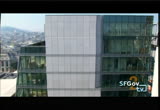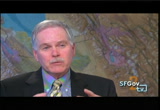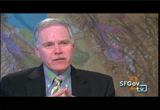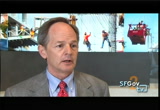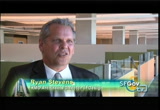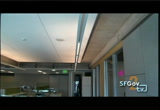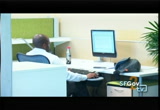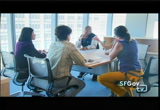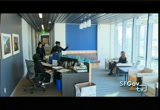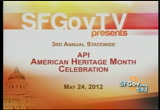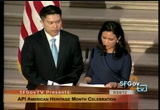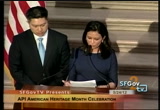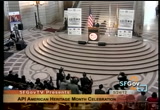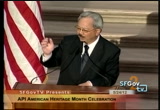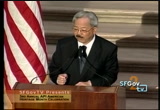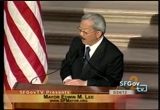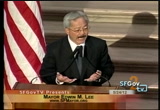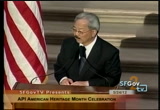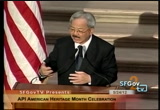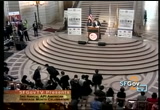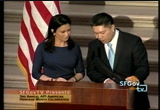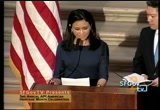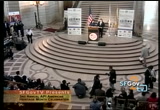tv [untitled] December 19, 2012 1:30pm-2:00pm PST
1:30 pm
>> san francisco is home to some of the most innovative companies of the 21st century. this pioneering and forward looking spirit is alive in san francisco government as well. the new headquarters of the san francisco public utilities commission at a5 25 golden gate avenue is more than just a 13-story building and office ablation. instead, city leaders, departments and project managers join forces with local architectural firms ked to build one of the greatest office buildings in america. that's more than a building. that's a living system. ♪ ♪
1:31 pm
when san francisco first bought this land in 1999, it was home to a state office building. >> this was an old eight-story brown building the state owned and the workers' comp people were in that building. it was an old dee correctvth it building for decades. when i was a member of the board of supervisors, all of us wondered why we hadn't done anything there and the mayor thought the same. >> if an earthquake happened, the building was uninhabitable. it sat there vacant for quite a while. the city decided to buy the building in 1999 for $2. we worked and looked at ways that we can utilize the building for an office building. to build an icon i can building that will house a lot of city departments. >> the san francisco public utilities commission has an important job. we provide clean, pristine public drinking water to 2.6 million people in the san francisco bay area from the hetch hetchy regional water system. with also generate clean renewable energy for city
1:32 pm
services like public buses, hospitals, schools, and much more. and finally, we collect and treat all the city's wastewater and stormwater making it safe enough to discharge into the san francisco bay and pacific ocean. >> in 2006 the puc was planning a record number of projects. >> the public utilities commission is a very infrastructure-rich organization. we're out there rebuilding the water system. we've budget working on power generation in the country. we've been doing sewer for the city. we're looking at a brand-new rebuild of all watt systems in san francisco and we haven't had a home that's been other than mental. >> they staff over 900 people. the puc is in two office locations. >> you know, this is such a great place for a building. if the puc owned that building and we could make that the icon i can sustainable building puc represents, wouldn't be a dramatic idea? >> so, one of the major decisions we made was we wanted
1:33 pm
to make a statement with this building. we wanted this building to be a lead platinum building which is very few buildings in san francisco that achieved this mark. >> leadership and energy environmental design, it takes a look at the way we think about the places where we live and work. i like to think of it as designed for human and environmental health. lead addresses five categories that enhances environment. indoor air quality, energy, water, materials and resources, and sustainable sites are the five categories for the lead. you can go for several gold or platinum certifications. >> the city wanted to be silver lead status. . maybe gold was a stretch. and people said, if we're going to be a sustainable organization that the pucs this has got to be the top of the line. it's got to be a lead platinum building. what does that mean to us? we run water, power, and sewer. so, those are some of the
1:34 pm
biggest things involved in lead platinum. ♪ ♪ >> by late 2008 the project, as we got the contractor on board and we were able to start pricing it, we're a multi-, multi-, multi-million dollar over budget. >> the story a lot of people don't know after we got select today do this project, the first price we came in with was $180 million. and the city said, you know, this is a great building, but we just don't want to spend that much money. so, the project was on the verge of being canceled. >> if you're looking at why this building came to be, in many ways it also included mayor gavin newsome, particularly, who really had an affection for this building. he saw the design. he saw the potential. he wanted to make sure that that building got built. and he said, do what you need to do, but please, if you can make that building work, we need to have that building in civic center. >> i happened to be at a green
1:35 pm
conference santa clara. he said you shouldn't cancel that project. can you work with us? michael cohen phoned me up the next day. can we cut $40 million out of this project? it was one person more responsible than any others, it's tony irons, was the architect that was responsible for the revitalization of city hall who came to my office and said, we cannot abandon this. we can't walk away from this project. we have an opportunity to really take a lot of our values and principles, particularly raising the bar as we did as a city on our green building standards, mandating the most aggressive green building standards for private construction anywhere in the united states. and showcasing them in this new building. >> the city for the sfpuc, it was critical that the building stay as a lead building. the easiest thing to do to cut out millions of dollars, let's just go from lead platinum to lead gold. but that wasn't the objective. this needed to be the best
1:36 pm
example of energy conservation of any office building in the united states. >> we became involved in the san francisco public utilities headquarter project during the time when the project was at a stand still for a number of reasons, largely due to budget issues. and at the time we were asked to consider an alternative design using concrete rather than the scheme that was potentially planned for previous to that, which was a steel frame structure that used hydraulic dampers to control seismic motion. >> so, i met with my team. we worked hard. we came up with a great idea. let's take out the heavy steel structure, let's put in an innovative vertical post tension concrete structure, great idea. we did that. a lot of other things. and we came up with a price of 140 million. so, we achieved that goal. and, so, when we first started looking at the building, it was going to cost a lot of money. because of the way it was being
1:37 pm
built, we could only get 12 floors. we wanted more space for our employees. we ended up going and saying, okay, if we do a concrete building instead, which was web core's idea, we can get 13 floors, not 12 floors. the concrete doesn't require much space between the floors as a steel building does. and it could be cheaper. yes, more space, less money, great idea. ♪ ♪ >> we know that right now there are things happening in power, with sewer, with water that are not always proven technologies, but they're things that are enough proven you should take a bit of a risk and you should show others it can be done. >> we're showing the world, suddenly had wind turbines which they didn't have before. so, our team realizing that time would change, and realizing where the opportunities were today, we said, you know what, we started
1:38 pm
out as really something to control wind as an asset, when you combine today's technology becomes something entirely different. >> wind turbines in an urban environment is a relatively new concept. there are a few buildings in other major cities where they have installed wind turbines on the roof. and wind turbines in buildings are effective. >> the discussion was do we do that or not? and the answer was, of course. if they're not perfect yet, they're building a building that will last 100 years. in 100 years someone is going to perfect wind efficient turbines. if these aren't right, we'll replace them. we have time to do that. >> the building that's two renewable energy generations. wind turbines located on the north facade. two different levels of photo volume takes. >> we have over 600 solar panels and three platforms on the building, and four integrated wind turbines. the wind turbines and the solar panels produce 7% of the building's energy.
1:39 pm
and we're reducing the use of energy here by 32% in the office building. >> the entire building is controlled by a complex computer system which monitors and adjusts air, heating and lights as well as indoor shades. >> the building is going to be a smart building. it's going to have all integrated features. so, it has a monitor on the roof that knows where the sun is. as it gets warmer or colder, it heats and cools the building. as it gets lighter, shades can go up or down to make sure that you're not over using any kind of heat or air conditioning, but as it gets darker the shades can go back up. the lights inside the building self-adjust depending how close they are to the light sources outside, how light it is, how dark it is. so, you're not using energy more than you need. >> we also have occupancy sensors. if nobody is in that room, lights turn off.
1:40 pm
it's likely to have sustainable features. it's another thing to have an integrated systems sustainability. >> when you have a building that's lead platinum, there are a couple themes important. one is daylight harvesting where you harvest the daylight and have it penetrate the building so that people have views, they see sunlight, which means that partitions and workstations are much lower so that people can see. >> so, human comfort combined with light reduction, the amount of electric light reduction, all with the aim of creating, you know, a marvelous workplace that people want to come to, feel comfortable working in, thrive at what they're doing, all kind of integrate together. and the daylighting lighting strategy is a very important part of that equation. >> one of the keys to this building is that we're maximizing the use of natural daylight to light the building.
1:41 pm
>> here in our south facade we have light shells. they help shade the floor, but as well light bounces off of the light shells into the interior of the floor providing more daylight into the interior of the floor. lighting is both the greatest use of energy consumption in an office building, but it also contributes to the largest amount of heat gain in the building. we're maximizing the use of natural daylighting. we also have light sensors that minimize the use of artificial lighting. >> by having light outside the building skin, what that does is we are mitigating it before it hits the glass. we have a high performance, low formal gain graph. the system does not have to work as much to either cool the building or heat the building. >> this building also incorporates or utilizes under floor system for delivery of heating and cooling to the building.
1:45 pm
we would like to welcome you to the third annual statewide celebration and recognition of asian-pacific islander american heritage month. this event is hosted by the mayor. i will tell you a little bit more. it is a non-profit, non- partisan. since 2001, our focus has been on educating the public on public policy. and fostering the future leaders from our minority communities to serve at federal, state, and local levels. the mission is to empower patients and pacific islander americans in civic and public affairs to education, active participation, and leadership development.
1:46 pm
>> civic engagement, leadership development, and community servthe theme of tonight's evens a celebration of the achievements and accomplishments of asian-americans in the state of california and our nation. >> ok'ing. -- ok. i would like to introduce our host for this evening. very well known as the first asian-american mayor in san francisco history. mayor lee championed balancing the budget to keep san francisco safe, solvents, and successful. he reformed city pensions. his focus is on economic development, job creation, and building san francisco's future. a great job, especially for helping out families.
1:47 pm
we want to keep families here. i also wanted to mention a little bit of his past. he was born in 1952 in the beacon hill neighborhood of seattle, washington. his parents immigrated to the u.s. from china and the 1930's. his father fought in world war ii and worked as a cook. he passed away when the mayor was 15. his mother was a seamstress and a waitress. mayor lee has five siblings, he graduated from college in maine, he also went to uc- berkeley law school and finished in 1978. he and his wife have two daughters. i also want to mention, prior to becoming mayor, one of the key
1:48 pm
points in his contributions to the community is after he completed law school, he worked as a managing attorney for the san francisco asian law caucus, where he was an advocate for affordable housing and the rights of immigrants and renters. mayor lee -- [applause] >> thank you. welcome to city hall. the people's city hall, san francisco. i want you all to note that that was such a wonderful rendition of our national anthem. please give another applause to the millennium -- melanie and
1:49 pm
her daughter. i am so excited about all of you and seen so many of you from all over our state. come to city hall anin san francisco, welcome. i would like to welcome the former secretary of transportation. [applause] thank you for being here. thank you, john, thank you. our board of supervisors comment david chiu, thank you very much. david campos, thank you for being here.
1:50 pm
he is our adopted asian brother. we have so many of our state representatives here. so many of you are here. i have spent all night announcing your names, but they did not give me the full list. i will say thank you on behalf of our city. from sacramento, los angeles, from all the communities in between, thank you for coming to our fantastic city to celebrate our asian-pacific heritage month. it is my pleasure to also provide you with a warm welcome and thank you for somebody who worked on this idea to bring everybody here to san francisco, my very good friend. thank you. where are you? when we first talked about this, we said there had to be
1:51 pm
the place where everybody felt comfortable. there had to be a place where we could feel the excitement of all very different asian american groups. we had to have a place where something wonderful had been accomplished. a leadership change, one that we never thought in our lifetimes. by the way, as you know, i never thought in our lifetimes we would see an african-american president of the united states. what a wonderful location, that is something to celebrate. he has been here many times, president obama. the very surprised we had of being able to celebrate the first asian mayor of san francisco. it was not my doing, it was all of the people of san francisco saying it is about time we celebrate. thank you to the people of san
1:52 pm
[applause] i have a very short message. what did i have felt very strongly in my first elected year, but also during my tenure as interim mayor. we have a great deal of celebrate. we also have a great challenge in front of us. there are so many of our asian american friends, iranian friends, friends from the philippines, friends from our japanese-american community, are chinese-american community, waiting for the opportunity to come together to celebrate our diversity, but also to signal to our european friends, our latino france, we are ready to help lead this state. and helped change the conversation and not only celebrate diversity, but use diversity for our strength.
1:53 pm
that is our strength. i want to signal to you, let's come together, let's use this opportunity to make sure we can celebrate our strength throughout the state. i also want to welcome carmen chu. thank you for joining us. we can really celebrate and we can bring this state for because i know -- he does not want to be alone in san francisco suggesting change. nobody wants to be alone. all of us can contribute to a more positive outlook on life. guess what -- when we look at where we came from, when we look at the parents that brought us here, the generations before us, we learned a great lesson.
1:54 pm
we learned lessons they faced, there were struggling to get past the barriers of discrimination. past the barriers of economic privilege, past the barriers of the new immigrants to this country. they forged ahead. some of us aren't new generations, the generation of kids i want to -- some of us are new generations. make sure they have a big opportunity in san francisco. we hope you do not have those barriers that our parents did. we hope that you do not run into the road blocks that we had to struggle for. we hope that our lawsuits, are street advocacy, -- our street advocacy, and all the places we struggled with in our generations, that you never have to go through. the only way we can do that is to make sure the door is always
1:55 pm
open to everybody else. that is our promise, we have to keep that, we have to keep our education strong, we have to keep our economic foundation strong, we have to keep our opportunities strong. thank you. i am honored. let us celebrate. on behalf of the city and county of san francisco, i officially declare this to be asian pacific heritage month in san francisco and the state of california. welcome. [applause] >> i am going to make one correction. he said president obama is the first african-american president. president obama crew up in hawaii. -- grew up in hawaii. it makes him an honorary asian-
1:56 pm
american. he is the first asian-american president as well. tonight's events would not be possible without our community partners. a group that helped make all this happened, i am going to read them all. the asian business alliance, asian law alliance, the asian pacific american leadership institute, chinese-american cultural association, chinese american political association, citizens for better community, culture to culture, why in the chamber of commerce of northern care of -- kawai and chamber of commerce of northern california, northern california chinese athletic association,
1:57 pm
national association of american professionals, national federation of independent business, national federation of filipino americans, the filipino chamber of commerce, around of applause for all of our community partners, please. that was a lot. [applause] >> i am so glad he had to do that. our next speaker is u.s. congressmen. he is representing the 15th congressional district of california in the u.s. house of representatives. in congress, he is a member of the powerful house appropriations and budget committee.
1:58 pm
share of the democratic caucuses, new media working group, house democratic senior went, and the original author of the equity and excellence commission now housed in the u.s. department of education. his district includes silicon valley, the birthplace of technology. mike has dedicated his life to public service and is lauded for his work on education, civil- rights national service, immigration, transportation, the environment, and high-tech issues. >> he is also the greatest karaoke sing their -- singer and all of congress. -- in all of congress. [applause] >> he just told me i had five
1:59 pm
minutes. what do you think of this program? [applause] it is about time. i want to thank francis and fong. i think this is the very first statewide heritage month held with the mayor of san francisco. let me say something about heritage month in san francisco and your mayor. in the old days, you remember san francisco was known for passing all of these anti- chinese ordinances to limit the movement, the productivity of chinese in the city. we know two things. change happens.
107 Views
IN COLLECTIONS
SFGTV2: San Francisco Government Television Television Archive
Television Archive  Television Archive News Search Service
Television Archive News Search Service 
Uploaded by TV Archive on

 Live Music Archive
Live Music Archive Librivox Free Audio
Librivox Free Audio Metropolitan Museum
Metropolitan Museum Cleveland Museum of Art
Cleveland Museum of Art Internet Arcade
Internet Arcade Console Living Room
Console Living Room Books to Borrow
Books to Borrow Open Library
Open Library TV News
TV News Understanding 9/11
Understanding 9/11
